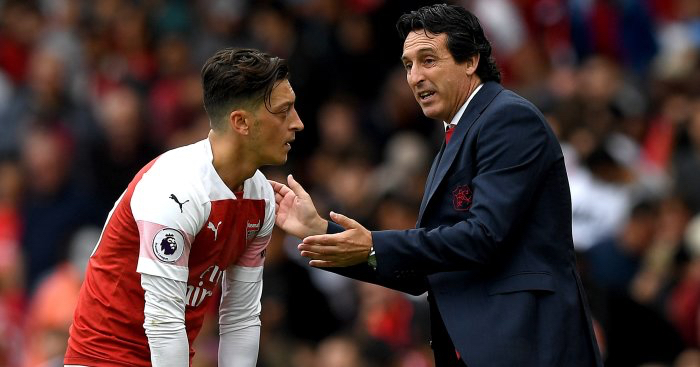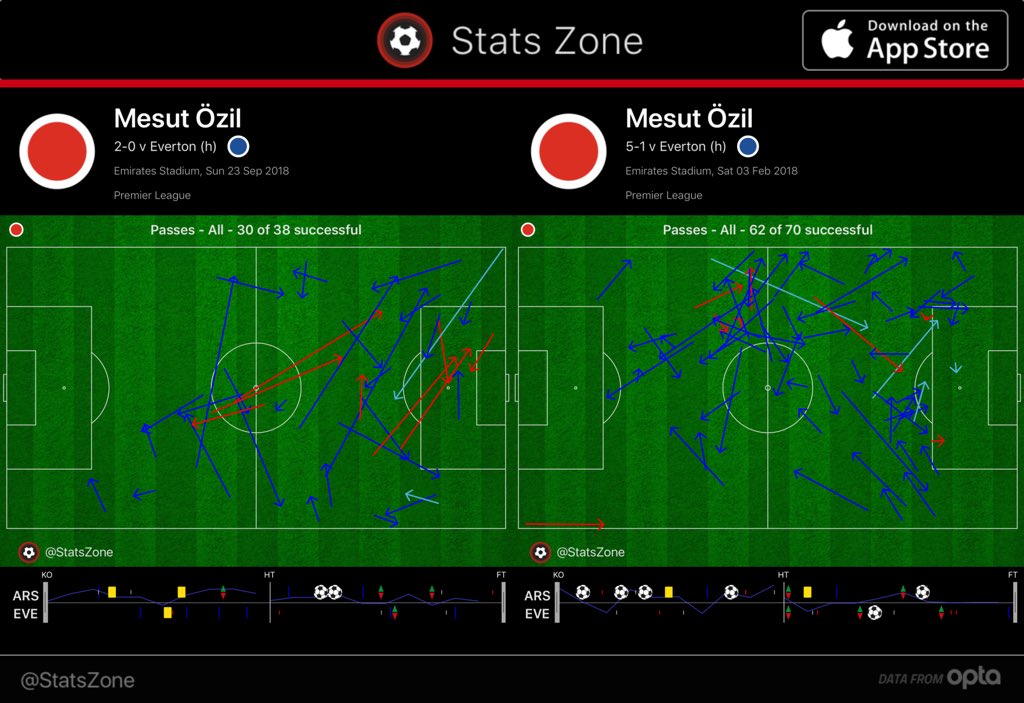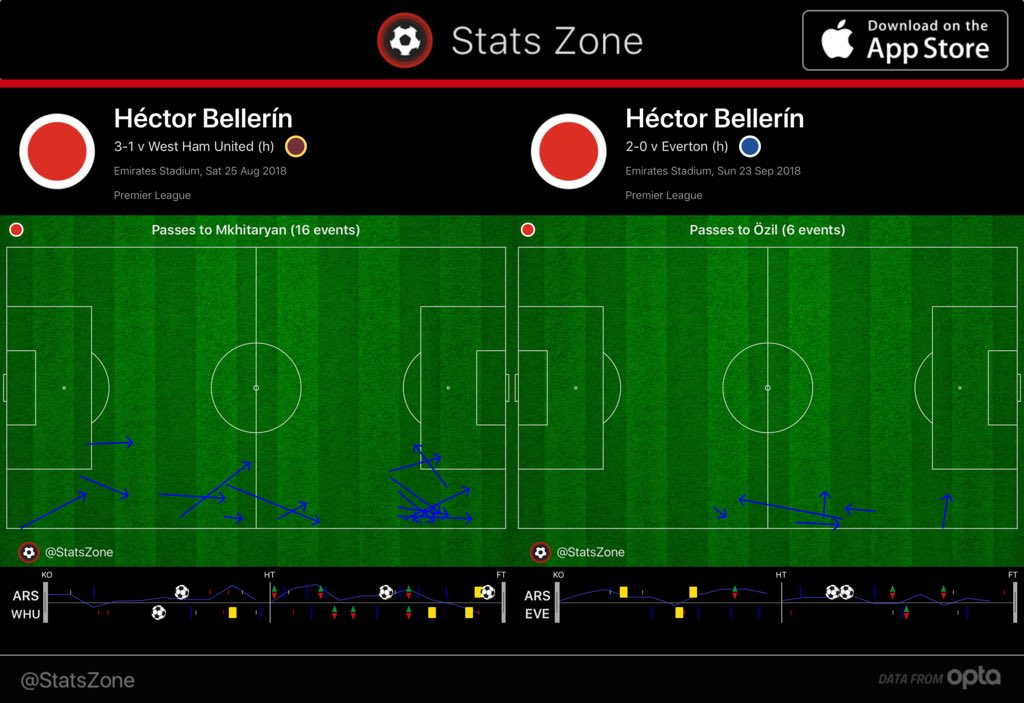This is part two of a three part series on Mesut Ozil by Oscar Wood.
Yesterday we took a detailed dive on Özil’s 2017/18 season.
An interesting aspect of Mesut Özil is that while opinions of him are vulnerable to extreme fluctuations, his performance levels, and the statistical output he produces, are usually strikingly consistent. Such is the quality and repeatability of his core technical and mental attributes - ball control, passing, movement, decision making, vision - he rarely has an outright bad game, where he performs those aforementioned skills poorly (one rare example was actually the opening day against Manchester City, where his final third passing was a letdown). The most common reason for Özil having a mediocre game is usually external; when he’s put in a position where he can’t utilise his strengths and his weaknesses are exposed more. Usually this is when Arsenal struggle to get control of games and he simply doesn’t see as much of the ball as he’d like. In other words, it’s the age old cliche about how he can’t grab a game by the scruff of the neck, unless it’s there for the taking.
This isn’t an issue for him over a sustained period of matches. Or at least, it hasn’t been so far in his career. Of course, like any player, he goes through physical ups and downs as well, meaning sometimes he has better months than others. But, whereas others like Aaron Ramsey and Henrikh Mkhitaryan may often have games where their touch and weight of pass is off, with Özil you usually know what you're going to get. Often his supposed up and down periods are simply down to the nature of assists. The finish is beyond your control and there’ll be periods where the other forwards run hot and periods where they run cold.
All this makes his start to the season all the more alarming. The Arsenal fanbase and wider football world has had many moments of doubt surrounding the German before, but it’s rare that a period of Özil scepticism has been matched with a significant drop off in his statistical performance as well. Arsenal’s number 10 is currently underperforming in virtually every metric, with his creativity and overall passing numbers significantly worse than last season.
While, as mentioned earlier, Özil’s statistics have tended to stay consistent over medium term periods, and we are still very early in the season, the fact Arsenal have a new coach has exasperated fears that Özil’s recent performances could be the start of a new long term trend. Arguably most striking is the drop off in overall involvement. While days can happen where a player fails to create moments of spark, a lack of involvement in possession indicates potential systemic issues. In the Premier League so far this season Özil has completed just 31.1 passes per 90 minutes, less than half of his career high figure in 17/18. To put things into perspective, in a typical game last season only Xhaka would play more passes. This season only Lacazette, Aubameyang and Cech are attempting fewer.
So what factors could be behind Özil’s poor performances this season, and in particular, his lack of involvement compared to previous years? The most obvious change has been in his starting position. Emery has started Özil on the right in four of his five starts. Wenger, of course, almost always used Özil in a primarily central role, with only occasional spells on the wing, such as early in 14/15 and during the European run last season. From his number 10 position Özil had plenty of attacking freedom and regularly ventured to the wings anyway, but he also had responsibility to move towards the centre circle and offer himself in possession when both central midfielders were on the ball. Just look at the areas and volume of his passing on Sunday compared to when Everton came to the Emirates in February.
Özil arguably hasn't been helped by Arsenal’s left side bias in recent matches. In their last three games the Gunners have found progressing the ball up the left side of the pitch a lot easier than building through the right. One reason for this may be Granit Xhaka. Xhaka has usually been the dominant presence in possession, and as a left footer he’s more comfortable patrolling the left side of the pitch and circulating the ball to that side. It’s notable that despite nominally starting on the right, a lot of Özil’s involvement against Everton still came on the left wing.
In fact, Xhaka’s preference for left sided passing, and Özil’s positioning on the right has significantly disrupted their on pitch relationship. While Xhaka didn’t have his best individual season last year, one thing he did do well was give the ball to Özil. Xhaka to Özil was regularly one of Arsenal’s most prolific pass combinations. The holding midfielder is usually Arsenal’s highest volume passer, and thus a lot of Arsenal’s attacks go through him. With so many of his passes going to Özil, it’s not a surprise the then number 11 followed him as Arsenal’s second most frequent passer in 17/18.
This season that relationship has broken off. On Sunday only 7 of Xhaka’s 82 completed passes found Özil, just under 9%. In the same fixture last season, which Arsenal won 5-1, 17 of Xhaka’s 73 went to Özil, 23%. Equally important is the location of their combinations. On Sunday the few times Xhaka did find Özil was when Özil made rare venues to the left wing. There were only a couple in the central areas of the pitch, while in the fixture last season, the majority came in those spaces. Without that direct exchange with Xhaka, the ball has to go through different routes to get to Arsenal’s number ten, and it’s not a surprise he's seeing a lot less of the ball.
It’s likely that a simple change of putting Özil back into the centre will not only prevent him from being isolated on one wing, but will also help Arsenal’s build up play and overall balance in possession. The central midfielders will have easier forward pass options, as Özil is more comfortable receiving in the number ten space than Ramsey is. If Aubameyang were to continue on the left, then getting Özil on the ball frequently in central areas could help him to operate as more of an outlet. The irony of Arsenal’s current left side bias is that while their best playmaker feels isolated on the right, their best outlet and poacher in the box is regularly involved in build up on the touchline, far from goal, and is often having to put crosses in for others when ideally he’d be the one getting on the end of moves. In these last few matches the rare times Özil has moved away from his position on the right have been some of the rare times Arsenal have looked potent going forward. His role in the build up to Aubameyang’s goal at Cardiff is an example.
Against Chelsea and West Ham, Mkhitaryan was used on the right, with Özil central for one and absent for the other. Bellerin and Mkhitaryan enjoyed their partnership, and Arsenal did a lot more attacking down that wing in those two games. As @ThatGooner alluded to in his thread, Mkhitaryan likes to make runs behind into the channels, which creates space and allows a run for the right back to try and pick out. While Özil can make those kind of runs, it’s more of a change up option for him. He usually likes to come short and drift inside, and Bellerin hasn’t been able to build the same sort of partnership with him during build up, which has contributed to Arsenal's left side bias.
Occasionally it'll be suggested that Özil’s form last autumn was down to him playing for a new contract, and that after securing a huge wage increase, he’s reached a comfort level that is hindering his motivation. That is a possibility. But it’s also a malicious accusation to throw at an elite athlete who has worked hard his whole life on improving his craft. His Europa League performances last season also show there's still hunger there beneath his usual solemn demeanour. Given his play style, Özil should still have more years to give to Arsenal at something close to peak level. If Arsenal are to play their best attacking football, if the Unai Emery era is to become a success, or if Arsenal simply want to avoid financial disaster, it’s imperative Emery finds a way to get more out of Arsenal's highest earner, and most gifted footballer.
The most obvious reason that Özil has been shafted wide is because of Emery’s preference for using Ramsey as the number ten. In part three we’ll look at the difficulties of accommodating both Özil and Ramsey in the same team.
Oscar is on Twitter @Reunewal. Follow him there.






